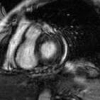Free Online Productivity Tools
i2Speak
i2Symbol
i2OCR
iTex2Img
iWeb2Print
iWeb2Shot
i2Type
iPdf2Split
iPdf2Merge
i2Bopomofo
i2Arabic
i2Style
i2Image
i2PDF
iLatex2Rtf
Sci2ools
ISBI
2008
IEEE
2008
IEEE
Segmentation of the evolving left ventricle by learning the dynamics
We propose a method for recursive segmentation of the left ventricle (LV) across a temporal sequence of magnetic resonance (MR) images. The approach involves a technique for learning the LV boundary dynamics together with a particle-based inference algorithm on a loopy graphical model capturing the temporal periodicity of the heart. The dynamic system state is a low-dimensional representation of the boundary, and boundary estimation involves incorporating curve evolution into state estimation. By formulating the problem as one of state estimation, the segmentation at each particular time is based not only on the data observed at that instant, but also on predictions based on past and future boundary estimates. We assess and demonstrate the effectiveness of the proposed framework on a large data set of breath-hold cardiac MR image sequences.
Boundary Estimation | Future Boundary Estimates | ISBI 2008 | LV Boundary Dynamics | Medical Imaging |
| Added | 20 Nov 2009 |
| Updated | 20 Nov 2009 |
| Type | Conference |
| Year | 2008 |
| Where | ISBI |
| Authors | Walter Sun, Müjdat Çetin, Raymond Chan, Alan S. Willsky |
Comments (0)

